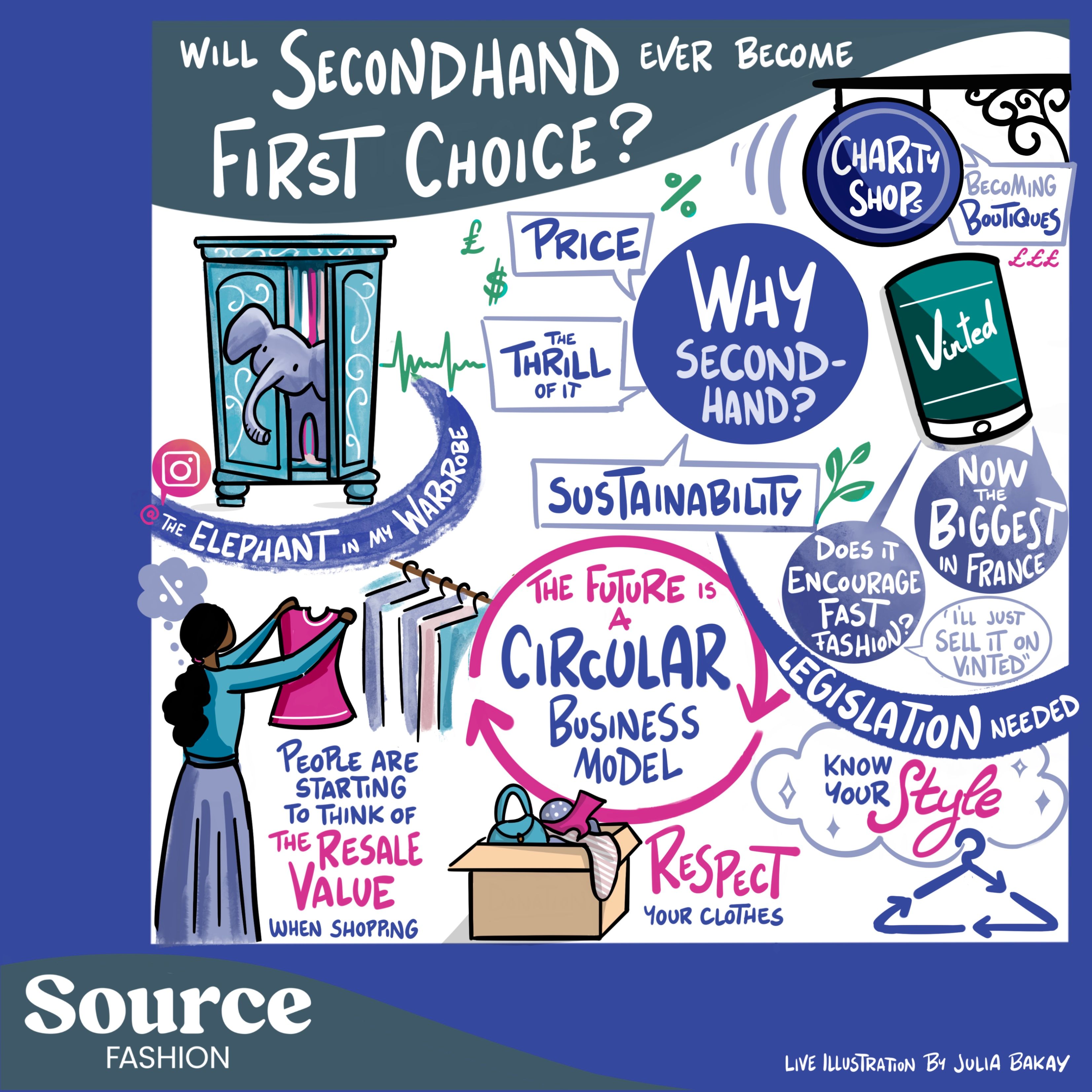Will secondhand ever be first choice?
)
Welcome to Source Illustrated - a blog series built from the energy and ideas of our Source Debates stage at Source Fashion, July 2025. We teamed up with Julia Bakay, who captured the energy and ideas into a powerful infographic. Each week we'll explore the themes from the artwork, uncovering the ideas around some of the industry's most pressing questions.
Want to see them in action? Register here for the next show
The elephant in our wardrobe
There’s an elephant in all our wardrobes. It hides between the blazers that just don't fit right any more, the tops that still have their tags, and the jeans that have lost their colour. This elephant is waste. It’s overconsumption. It’s the reminder that our relationship with fashion has been built on excess, and that excess is catching up with us.
It’s no coincidence that The Elephant in My Wardrobe is also the name of Gemma Meatheringham’s company, founded to spark conversation around our habits as consumers and the hidden impact of fashion. Gemma, who chaired the Source Fashion debate on whether secondhand could ever become first choice, has spent her career asking exactly these questions: how do we confront the uncomfortable truths in our closets, and what would it take to reimagine them?
For decades, secondhand clothing sat on the margins of fashion. It was for bargain hunters, students, or those with a keen eye for fashion. New was equal to desirable (and trendy?); old equalled worn out. But over the last few years, that story is being rewritten. Today, the resale market is one of the fastest-growing segments in fashion. Platforms like Vinted and Depop have millions of active users. Charity shops are curating their rails like boutiques. Vintage is no longer niche - for lots of us, it's the only way we shop.
The question is no longer if secondhand has a future. The question is whether it will ever become our first choice, and how can we use it to really make a dent in the reducing our environmental impact?

The thrill of discovery
Ask anyone who shops secondhand regularly about their motivation, and they’ll talk about the thrill. There’s something irresistible about walking into a charity shop and spotting a designer blazer on the rail for £15. Or scrolling Vinted late at night and finding the exact pair of sold-out trainers you’d been hunting for.
Unlike the neat rows of duplicates in a fast-fashion store, secondhand is about discovery. It feels personal, almost serendipitous. Every piece comes with its own story. That sense of individuality is especially appealing in an age where social media has turned wardrobes into public galleries. Posting an outfit is no longer just about wearing the latest trend - it’s about showing off your unique finds, the pieces that nobody else will have; and often the tale of the search along with it.
Secondhand fashion feeds that desire for self-expression that the fashion industry is built upon and can get forgotten about in this era of newness and never-ending microtrends. It gives people a way to carve out a style that feels truly theirs. And that makes it addictive. Shopping becomes less about consuming and more about hunting, curating, and discovering.
Price, value, and resale thinking
Of course, money plays a huge role. With living costs rising across the globe, secondhand offers an obvious solution. For some, it’s the only way to keep wardrobes refreshed. For others, it’s about stretching their budget further while still looking good.
But something deeper is happening: the way people think about value is shifting. Increasingly, shoppers are considering resale value before they buy. A jacket isn’t just a purchase - it’s an investment. It holds potential future worth. That mindset reframes fashion from being disposable to being an asset - something that use to be reserved only for high-end pieces.
This kind of calculation is becoming more common, especially among Gen Z and millennials. It encourages smarter choices: buying items that last, that hold their value, and that can be recirculated and also make the purchase a bit sweeter to swallow!
This resale mindset doesn’t just benefit consumers. It pressures brands to create pieces that really last. If an item falls apart after three washes, it won’t have resale value, and consumers know it. In this way, secondhand demand quietly nudges the entire industry toward better quality and durability.
Sustainability and respect for clothes
Buying secondhand is one of the simplest ways individuals can reduce their footprint. Every pre-loved purchase avoids the need for new resources, new energy, and new emissions. And beyond the data, there’s an emotional pull. Choosing secondhand is a way of saying: I respect this garment, and I respect the resources and people that made it possible.
This respect reshapes how we view our wardrobes. Instead of treating clothes as disposable, we start seeing them as valuable. Repairing becomes an act of care. Donating or reselling becomes part of the garment’s journey. Secondhand doesn’t just extend the life of clothes - it transforms the culture around fashion itself, becoming an attitude and ideological shift that's really needed to contribute to a more circular industry.
Charity shops becoming boutiques
Walk into many charity shops today and you’ll notice a difference. The rails are better organised. The windows are curated. Some even mimic the look and feel of boutiques. This shift is intentional. Secondhand retail is no longer apologising for itself - it’s stepping confidently into the mainstream.
The transformation is about perception. When secondhand feels stylish, clean, and aspirational, it attracts new shoppers who might once have turned away. Add to that the convenience and polish of online resale platforms, and suddenly secondhand doesn’t feel second-class. It feels like an upgrade.
This matters because consumer habits are sticky. People want frictionless shopping. Once secondhand becomes as easy and enjoyable as buying new, the psychological barrier dissolves. The result? A cultural reset where pre-loved becomes not just acceptable, but aspirational.
Platforms like Vinted: mainstream proof
If you want proof of how mainstream secondhand has become, look at France. Vinted is now the biggest fashion platform in the country, surpassing even fast fashion giants. Millions of users buy and sell daily, creating an ecosystem that rivals traditional retail.
The appeal is clear: Vinted and platforms like it combine convenience, affordability, and sustainability in one package. You can shop from your sofa, find endless variety, and know that your purchase is giving clothes a second life.
But growth brings questions. Does the ease of resale encourage overconsumption? If shoppers think, I’ll just sell it on Vinted later, does that justify buying more in the first place? The resale economy can either slow down waste - or accelerate it. The answer depends on whether consumers and brands approach secondhand as part of a circular model or just another outlet for fast consumption.
The future is circular
Circularity is the key to making secondhand more than a trend. A circular business model moves fashion away from the linear path of take, make, dispose and towards a loop where garments are designed to last, to be repaired, to be resold, and eventually recycled.
For brands, this means rethinking design. Clothes should be durable, repairable, and made from materials that can be safely recycled at the end of their life. Some companies are already experimenting - launching take-back schemes, offering branded resale platforms, or even designing modular garments that can be adapted over time.
For consumers, circularity means treating clothes differently. It means repairing before replacing, reselling instead of discarding, and choosing items built to last. In this vision, secondhand isn’t just one option among many. It’s the beating heart of a fashion system that finally respects its own limits.
Legislation needed
But let’s be clear: voluntary change won’t get us far enough, fast enough. Legislation is essential if secondhand and circularity are to scale. Governments must step in with policies that reward sustainable practices and penalise waste.
Extended Producer Responsibility (EPR) is one approach gaining traction. Under EPR, brands are held accountable for the entire lifecycle of their products, from production to disposal. Imagine a world where a fast-fashion giant couldn’t simply churn out low-quality garments without bearing the cost of what happens when they inevitably end up in landfill.
Other policies could include tax breaks on repairs, stricter regulations on textile waste, or mandatory resale targets for large retailers. Legislation levels the playing field, ensuring that sustainability isn’t left up to individual goodwill but becomes an industry-wide requirement.
Knowing your style
For consumers, embracing secondhand also comes down to self-knowledge. Shopping sustainably isn’t about denying yourself or stripping back joy—it’s about knowing your style. When you have a strong sense of what suits you, you’re less likely to chase micro-trends. You shop with intention, not impulse.
Secondhand thrives in this environment because it rewards individuality. The rails of a charity shop or the listings on Depop aren’t dictated by the latest fashion week—they’re eclectic, unpredictable, and diverse. That forces you to focus on what you love, not what’s trending.
And when you know your style, every purchase feels more meaningful. You’re not just filling a gap in your wardrobe—you’re curating a collection that reflects who you are. That’s a far cry from the disposable culture that has dominated fashion for so long.
About the Debate
See the debates in action at the next show by registering here
This blog was inspired by the Source Fashion debate “Will Secondhand Ever Become First Choice?” hosted by Gemma Meatheringham, founder of The Elephant in My Wardrobe

